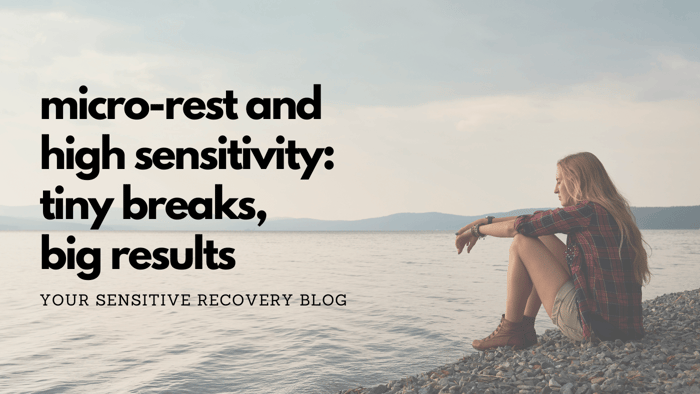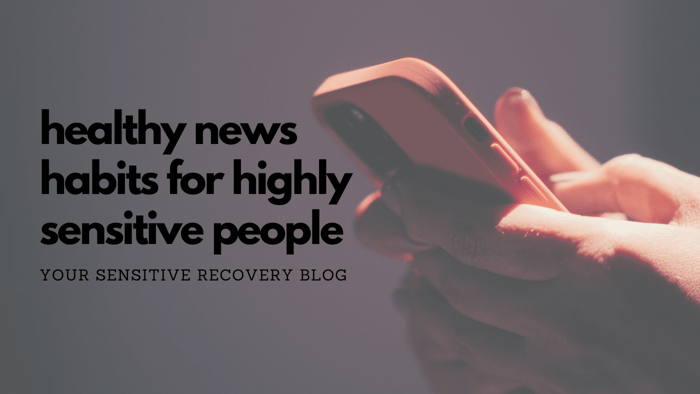As a Highly Sensitive Person (HSP), I love rest, but I've always struggled with naps due to a hyperawareness of my environment and the ever-present To-Do list. If you’re also Highly Sensitive, you probably already know that your nervous system needs a little more care than the average bear’s. But here's something you might not know: sometimes the most powerful kind of care is the smallest kind. Maybe a nap isn't in the picture, but...how about a micro-rest?
Micro-rests are short, intentional pauses that you can weave into your day that help soothe overstimulation (even prevent it) and boost calm and clarity. These moments don’t require a bed, a yoga mat, or a full hour carved out of your already-full day. Micro-rest is accessible, flexible, and surprisingly effective. And for HSPs, that's what we want. 🎉
What Is Micro-Rest?
Micro-rest is exactly what it sounds like: brief moments of rest, relaxation, and rejuvenation that help you regulate your nervous system. Think of it as the nervous system's version of a power nap, just without the nap. These breaks might last 30 seconds, a minute, maybe five. The point isn’t duration, it’s intention. You’re not checking out but consciously checking in.
A micro-rest might be:
- Three deep, slow breaths with your hand over your heart
- Sitting still with your eyes closed for 90 seconds (Eyes love a break!)
- Gazing out the window and watching the clouds
- Sipping tea while paying mindful attention to the taste and temperature
- Rolling your shoulders or relaxing your jaw
- Walking to the mailbox (or the bathroom 😉) without your phone
These aren't just other tasks on your to-do list. They're pauses that create more capacity for everything else.
Why Micro-Rest is Especially Beneficial for HSPs
As HSPs, our systems are wired to take in more information and process it more deeply. This makes us observant and empathetic...but it also makes us more prone to overstimulation and overwhelm. Loud noises, strong smells, bright lights, emotional intensity, or even just too much to do in one day can fry our circuits, fast.
You might notice signs of this in your own body:
- Brain fog or irritability
- A sudden drop in energy or mood
- Feeling jumpy or tightly wound
- A desperate urge to cancel everything and pull a blanket over your head
Micro-rest helps keep your system from getting to that point in the first place. It's a preventative tool - one that works best when it becomes a regular rhythm and not just a rescue mission.
Many of us are used to pushing through discomfort until we have to stop. But what might happen if we practice easing up before we reach our limit?
Rest Doesn’t Have to Be Big to Be Worthy
There’s a cultural story that says rest needs to be earned. That it has to be long and uninterrupted and productive in its own way. You know what I mean? But as an HSP, your body benefits from small, consistent regulation much more than occasional collapse.
Think of your nervous system like a sponge. Once it’s saturated with input, it can’t take anything else in until it’s squeezed out. Micro-rest gives you gentle squeezes throughout the day, so you don’t end up dripping all over everything.
And no, this doesn’t mean you’re fragile. It means you’re aware. You’re tending to your needs as they arise, instead of only responding when things feel unmanageable.
Listening to the whispers instead of waiting for the scream.
Simple Ways to Add Micro-Rests to Your Day
The beauty of these small, intentional moments of rest is that they’re accessible almost anywhere, at any time. You don’t have to change your schedule, just your approach. Here are some ways to try it:
1. Habit Stack It
Pair micro-rest with things you already do. After brushing your teeth, take three grounding breaths. After closing your laptop, sit still for 30 seconds. When your coffee’s brewing, do some gentle stretches.
2. Use Visual Cues
Sticky notes, calming images, or a gentle reminder on your phone can prompt you to pause. Try writing a simple phrase like “Soften” or “Be Here Now” and place it where you’ll see it often.
3. Body-Based Breaks
HSPs can disconnect from our bodies when we're overstimulated. A few moments of gentle movement, like neck rolls, shoulder shrugs, and placing your feet flat on the ground, can bring us back into the moment and into ourselves.
4. Anchor in the Senses
Micro-rest can be a sensory reset. Touch something soft. Smell an essential oil. Listen to soothing music. Let one sense take center stage for a minute or two.
5. Try 5-and-1
Commit to five micro-rests today, just one minute each. See how you feel. You don’t have to do it perfectly. You just have to start.
Rolling With Resistance
If you find yourself skipping over this idea or feeling like you “don’t have time” for micro-rest, I get it. That’s perfectly human. Many of us (especially those with a history of eating disorders or trauma) have learned to ignore our bodies’ needs to feel safe, productive, or in control.
But denying your need for rest doesn’t make you stronger. It just makes you more exhausted.
You’re allowed to take up space. You’re allowed to have needs. And those needs might be small, frequent, and completely valid. Start where you are. Start small. Trust that these tiny moments add up to something wonderful.
You don’t have to earn rest.
You don’t have to wait for a breakdown to care for yourself.
You’re allowed to pause - frequently, imperfectly, and with compassion. Because tiny breaks? They really can create big results.
😌
✨ Josie Munroe, LMFT is a licensed therapist and owner of JosieMunroe.com and Your Sensitive Recovery. As a recovered clinician and Highly Sensitive Person, she loves supporting others on their journeys to form new, empowered relationships with food, their bodies, and their sensitivity. Join the newsletter for a weekly boost of hope and inspiration. You deserve a recovery that works for you! ✨





